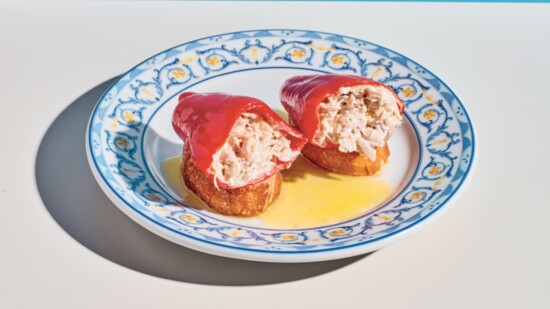On the northern coast of Spain sits a postcard-perfect town complete with glittering seaside, lush mountains in the distance, and church spires peeking through the skyline. San Sebastián boasts natural beauty, architecture, and a wealth of attractions. But what draws visitors there the most is something smaller in size — the pintxo.
The Spanish snack is tapa on a toothpick, a small portion of food held together with a skewer or served on bread. Locals are obsessed with them. Pinxtos, which originated in the 1920s, have evolved into miniature works of culinary art.
Going for pintxos, or poteo as the locals call it, is a hallowed pre-meal tradition. Having a drink before dinner is practically mandatory in the Basque Country, whether it’s a glass of Rioja red wine, local fizzy txakoli white, or a small glass of beer. Bar owners realized that by stringing together a few conserves and snacking ingredients lying around, they could create a new revenue stream. Voila! The pintxo was born.
In the last century, a pintxo has gone from a simple combination of ingredients like olives, cured fish, and pickled vegetables on a toothpick to avant-garde miniature dishes of braised beef in a shiny demi glacé or seared foie gras served over fresh apple compote. What makes pintxos special, however, is more than the yum factor—it’s the atmosphere and experience surrounding them.
Once visitors to San Sebastian get past the glistening Cantabrian Sea and the gorgeously green mountains nearby, they gravitate to the Parte Vieja, or Old Town. A bustle in the streets comes from all the people, glass of wine in hand, clustered around doors of tiny bars. Inside, plates piled with pintxos line the countertops.
The etiquette is simple: elbow your way in, step up to the bar and grab what looks best. Order a drink when you get the attention of the waiter, and pay for everything right before it’s time to leave. Using the honor system is a point of pride for locals in Basque. Pintxos are almost always eaten with friends, family, or co-workers, and the tradition is to create a bote, pooling money and paying together at each stop.
Many bars are family-owned and have been open nearly every day for 50 years. Bar Martinez is the oldest pintxo bar in Parte Vieja, opened in 1942 by a young married couple from the Rioja region. Their large family would sleep in the back and work from dawn to dusk, winning over locals and launching the family into restaurant fame in the city. Family photos line the walls, and pintxos deck the counter.
Every good pintxo bar has a specialty. Martinez’s is its pimiento relleno, or stuffed pepper. As with many traditional pintxos, it uses pantry staples like jarred roasted red piquillo peppers and cured tuna packed in olive oil to create the perfect bite. In this case, it’s a pepper stuffed with a tartar-like tuna salad, perched on bread and drizzled with sherry vinaigrette. A bite is simple yet so memorable.
Not making the thousand-mile trek to Basque Country any time soon? The beauty of pintxos is their versatility. You don’t have to have a bar counter at home to whip up your own pintxos with a group of friends. Embrace the spirit of poteo and serve a few different types of pintxos with a Spanish wine, and enjoy the joyful, convivial spirit of the pintxo without leaving home.
Pimiento Relleno de Bonito
TUNA-STUFFED PEPPER
This pintxo is more than the sum of its parts—a sweet, jewel-like piquillo pepper, roasted and stuffed with bonito del norte (tuna preserves) mixed with tartar sauce. The real secret to success lies in using the highest-quality ingredients.
Makes 12
1 baguette, sliced into 12 pieces
1⁄4 cup (60 ml) extra-virgin olive oil
1 tablespoon sherry vinegar
Kosher salt
1 jar or can (about 8 ounces/227 g) tuna in olive oil
1⁄4 cup (about 50 g) minced onion
2 tablespoons minced cornichons
1 tablespoon minced capers
1⁄4 cup plus 2 tablespoons (80 g) mayonnaise, preferably homemade
1⁄2 teaspoon dried tarragon
Freshly ground black pepper
12 piquillo peppers (from one 190 g jar)
Preheat the broiler. Arrange slices of bread on a baking sheet and broil until just toasted on the edges; the centers should still be chewy. Allow to cool.
Whisk together the olive oil and sherry vinegar in a small bowl. Season with salt. Set aside.
Drain the tuna and break it into tiny pieces in a medium bowl. Add the onion, cornichons, and capers, then add the mayonnaise, tarragon, and a generous pinch of black pepper and stir until the mixture comes together. If it looks dry, add a bit more mayo, but you want the mixture to hold together, not leak out of the peppers. Season with salt.
Distribute the mixture among the piquillo peppers, filling them gently with a spoon.
Arrange the toasted bread on a serving plate and place a stuffed pepper atop each piece. Sprinkle with salt. Drizzle generously with the sherry vinaigrette, allowing it to pool on the plate so the bread can soak it up from the bottom too. Serve immediately.
